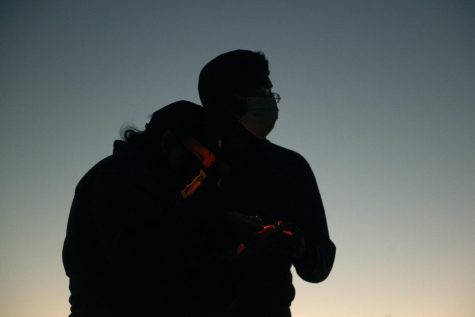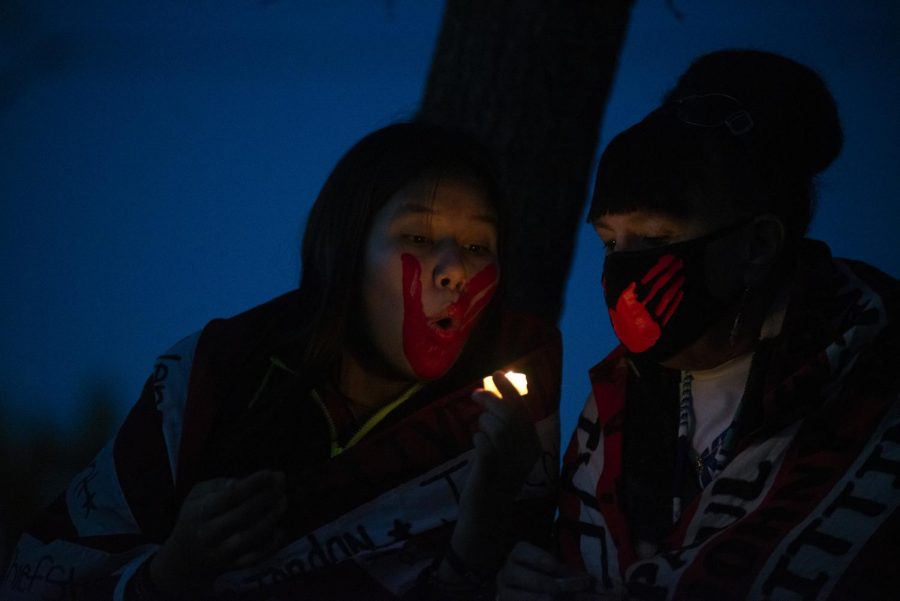Elisa Gomez. William “Billy” James Hughes.
The gentle beat of a drum was struck after every name was read aloud — each of an Indigenous life lost to gun violence, police brutality or kidnapping and killed.
Jonathon Tubby. Jamie Lee Wounded Arrow. Travis Jordan.
Nearly 100 people gathered at Boom Island Park Monday night in memory of lost loved ones and to celebrate Indigenous Peoples’ Day. The event was organized by various local groups, including Native Lives Matter (NLM), Justice for Travis Jordan, Black Lives Matter Minnesota and others.
This November approaches the two-year anniversary of Jordan’s death. His girlfriend, Taren Vang, said that after the loss of her boyfriend nothing can heal her, but the Indigenous community has lent her an ear.
Tonia Black Elk, an organizer for NLM, said Indigenous Peoples Day is not special: They are “Indigenous every day.”
“We don’t need your month; we don’t need your day. We live this every single day. … It means a lot to come out here to educate you guys on some of the issues that we got going on right here today,” Black Elk said.
Community members and families set up a display of pictures of Indigenous people who have died and red dresses to represent missing and murdered Indigenous women. Women dipped their hands in red paint and pressed them over their mouths to represent women kidnapped and murdered.
The Minnesota Department of Health found that despite making up only 1% of the population, Native American women were seven times more likely to be murdered than white women between 1990 and 2016.
Black Elk and her husband Gabriel work to help heal Native families that are grieving the deaths of loved ones. They reached out to Vang after hearing that the Minneapolis Police Department shot and killed Travis Jordan during a wellness check. The pair focuses on bringing awareness to the disproportionate rate at which Indigenous people are killed and supporting the families that suffer their absences.
“A lot of people see us as activists, but we’re a family,” Tonia said.

She said they will do anything to help, even if that just means sending a family a text letting them know they are being thought of or helping to get them groceries for the week.
The vigil started off with a land acknowledgment from Cantemaza (Neil McKay), the University of Minnesota’s Dakota language specialist and staff member in the American Indian Studies Department.
“The land that you’re standing on is Dakota. It is not American soil,” McKay said.
In recent years, Indigenous Peoples Day has overtaken the celebration of Columbus Day. Minneapolis first celebrated Indigenous Peoples Day in 2014.
Speakers said the day that Christopher Columbus landed on Native soil was the start of the mistreatment of their people. Gabriel Black Elk said it was significant when activists tore down the Columbus statue in St. Paul and that it is important for this generation to know what really happened to the Indigenous people when Columbus arrived.
Gabriel said Columbus was not an explorer but a killer.
“I had been trying to change the name of the day since I was 13. … I didn’t know how much longer I’d have to fight for justice,” he said. “But it just keeps going on.”
Gabriel’s brother, Paul Castaway, was killed in 2015 by Denver police during a wellness check. He said that organizing events and bringing together mourning communities is healing.
He said that to the families, protesters and supporters that spent their Monday night telling stories of those they miss, Indigenous Peoples Day represents all that their ancestors fought for and all that they will continue to work toward in the future.
“For me personally, [healing] is protesting, yelling out my brother’s name,” Gabriel said.























CapnRusty
Oct 23, 2020 at 12:36 pm
O.K. I give up. Tell me what “pog” means.
Jack Woodward
Oct 23, 2020 at 9:30 am
Sounds pretty pog
CapnRusty
Oct 15, 2020 at 12:40 pm
According to Darwin, each and every species must adapt to the ever-changing world, or perish.